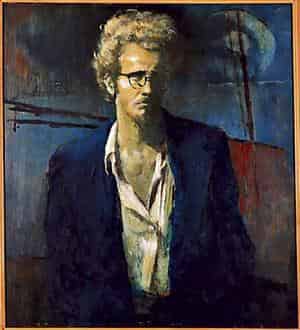Clifton Ernest Pugh
 Clifton Pugh self portrait
Clifton Pugh self portrait
Clifton Ernest Pugh (1924-1990), artist, was born on 17 December 1924 at Richmond, Melbourne, youngest of three sons of English-born Thomas Owen Pugh, assistant mechanical engineer, and his wife, Adelaide-born Violet Ogden, nee Cooke. His maternal grandfather was the astronomer W. E. Cooke. Clif attended state schools at Frankston, Auburn, Briar Hill and Eltham in Victoria, Taringa in Queensland, and Ivanhoe Grammar School in Melbourne in 1939, leaving school at 14.
Working as a junior in a newspaper office and at an aircraft factory, Pugh took evening classes in cartoon drawing at Swinburne Technical College in 1940. In 1942 he attended evening classes in life-drawing at the Australian School of Arts and Crafts, Adelaide, marking the beginning of a sustained interest in working from the model.
Pugh was conscripted into the Citizen Military Forces on 10 February 1943 and transferred to the Australian Imperial Force in April. After training in New South Wales and Queensland, he served in New Guinea in 1944-45 with the 2/2nd Battalion and in Japan in 1946-47 at the headquarters of the 34th Brigade. He was discharged in May 1947.
On 20 September 1947 Pugh married June Heather Rogasch, a stenographer, in the Church of Christ, Camberwell, Melbourne. They separated two years later. He attended the National Gallery School of Victoria (1948-52) under the Commonwealth Reconstruction Training Scheme. The dark hue of Pugh's oeuvre can be traced to the palette of his teacher, the Meldrum School portraitist (Sir) William Dargie.
In the 1950s Pugh first came to notice with depictions of indigenous flora and fauna in an interpretive, figurative style. His bush scenes struck a dramatic contrast, particularly with those of the Heidelberg School, for their denial of the sentimental in favour of harsh realism. His landscapes were innovative for their employment of a relatively loose brushstroke and layering of paint that imitated the disordered character of the Australian bush. A typical work is 'Meeting of the Apostle Birds' (1958), in which birds of the Cottles Bridge area, north-east of Melbourne, where he spent his adult life, are arranged in an artificial pattern over the detritus of the bush floor. In 'A Feral Cat' (1957) the introduced animal dominates the composition, emphasising its threat to native fauna.
Pugh held his first major one-man show in March 1957 at the Victorian Artists' Society. He became a vocal member of the Antipodeans, a group established in 1959 to defend figurative art. Other members were his artist friends, John Brack, Bob Dickerson, Arthur Boyd, David Boyd, Charles Blackman, John Perceval, and the art historian, Bernard Smith. Their exhibition at the VAS in August 1959 inspired several later reconstructions of the original show. Pugh received leading coverage in British newspapers in an exhibition of prominent Australian artists at the Whitechapel Gallery in London in 1961. He married Marlene Lorraine Harvey, his de facto wife of seventeen years and mother of his two sons, Shane and Dailan, at the Registrar-General's Office, Sydney on 23 June 1965. They were separated shortly afterwards.
Pugh was an Archibald prize winner: Rupert Henderson (1965), Sir John McEwen (1971) and Gough Whitlam (1972). Other portrait subjects ranged from his family to Australian political leaders and Prince Philip, the Duke of Edinburgh. He married his second de facto wife (1970-80) Judith Ley, who had changed her name by deed poll to Pugh, at the Westminster Registry Office, London, on 29 June 1976, with former prime minister Gough Whitlam attending as a witness. Adriane Strampp, who was to become an artist in her own right, was his de facto wife from 1980 to 1985.
Pugh was chairman (1972) of the Victorian Australian Labor Party arts advisory committee and member (1973-74) of the Australian Council for the Arts. He attracted much media attention, for his outspoken comments on political issues, his bohemian lifestyle and unconventional bush home. The house he built of mud brick and recycled materials called Dunmoochin was notable for its quirky architecture, objets d'art and paintings by those he knew and admired. The Dunmoochin Artists' Society, a community comprising potters and painters, was established from the early 1950s to further conservation, as well as art and craft issues. He was appointed AO in 1985. The Dunmoochin house was destroyed by fire in 2001 and replaced under the auspices of the Dunmoochin Foundation by two studios providing temporary accommodation for those interested in art or environmental matters.
Survived by his sons, Pugh died of acute myocardial infarction on 14 October 1990 at Prahran, Melbourne, and was cremated. His work is represented in most Australian public galleries and many overseas collections.
Traudi Allen The Australian Dictionary of Biography, Volume 18, (MUP), 2012
